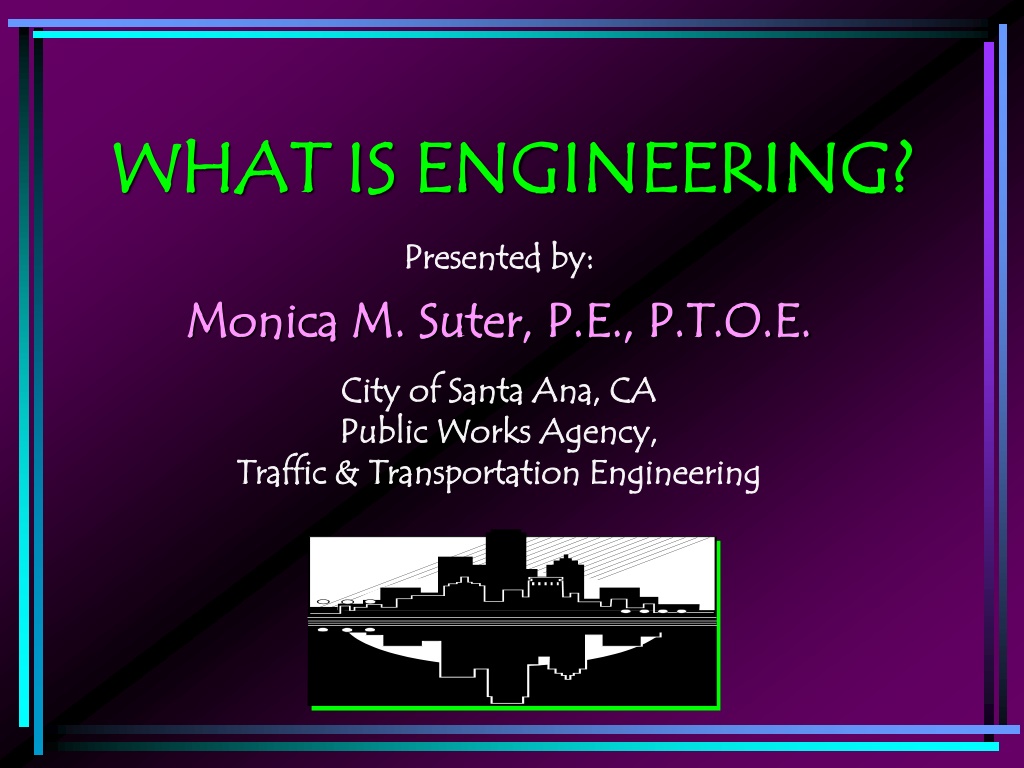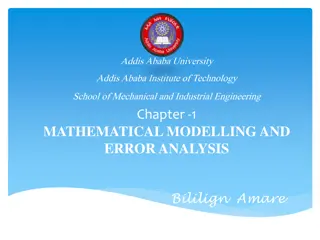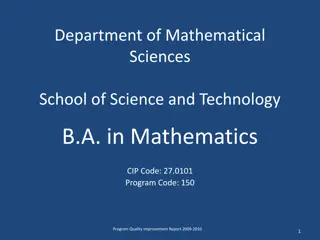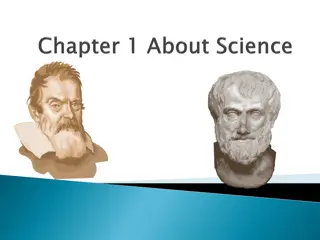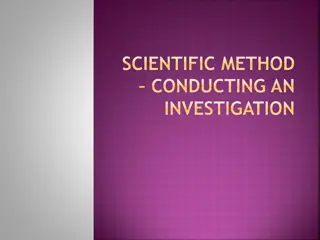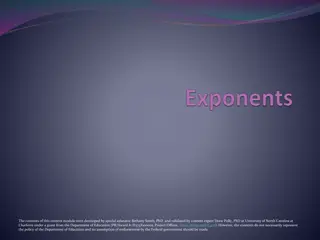Understanding Engineering: The Application of Scientific and Mathematical Principles
Engineering involves the application of scientific and mathematical principles to design, construct, or operate efficient, economical, and environmentally sound structures, equipment, or systems. There are four main types of engineers - Civil, Electrical, Mechanical, and Chemical - each specializing in different aspects of engineering to shape the world around us.
Download Presentation

Please find below an Image/Link to download the presentation.
The content on the website is provided AS IS for your information and personal use only. It may not be sold, licensed, or shared on other websites without obtaining consent from the author. Download presentation by click this link. If you encounter any issues during the download, it is possible that the publisher has removed the file from their server.
E N D
Presentation Transcript
WHAT IS ENGINEERING? WHAT IS ENGINEERING? Presented by: Presented by: Monica M. Suter, P.E., P.T.O.E. Monica M. Suter, P.E., P.T.O.E. City of Santa Ana, CA City of Santa Ana, CA Public Works Agency, Public Works Agency, Traffic & Transportation Engineering Traffic & Transportation Engineering
What is Engineering? What is Engineering? The application of: The application of: scientific & mathematical principles scientific & mathematical principles to obtain practical ends for the to obtain practical ends for the Design, Construction, or Operation of Design, Construction, or Operation of efficient, economical, & environmentally sound efficient, economical, & environmentally sound Structures, Equipment, or Systems for Structures, Equipment, or Systems for Just about Just about EVERYTHING AROUND YOU! EVERYTHING AROUND YOU! So, everything around you involves So, everything around you involves Engineering Engineering
What is Engineering? What is Engineering? There Are Four Main Types of Engineers Civil Civil - Buildings, bridges, transportation, traffic, water, soils, Buildings, bridges, transportation, traffic, water, soils, environmental, planning, tunnels, soils, seismic, airports, environmental, planning, tunnels, soils, seismic, airports, construction, surveying, foundations, ITS, retaining walls, sound construction, surveying, foundations, ITS, retaining walls, sound walls, grading, transit, railroad & highways walls, grading, transit, railroad & highways Electrical Electrical - - Computers (hardware/software), electronics, electrical designs for Computers (hardware/software), electronics, electrical designs for buildings, lighting, and transportation systems, systems design, & buildings, lighting, and transportation systems, systems design, & intelligent transportation systems (ITS) intelligent transportation systems (ITS) Mechanical Mechanical - - Automobiles, engines, airplanes, space shuttles, design of heating & Automobiles, engines, airplanes, space shuttles, design of heating & cooling systems & mechanical systems for buildings cooling systems & mechanical systems for buildings Chemical Chemical - - Chemistry related products, environmental, toxic waste, & Chemistry related products, environmental, toxic waste, & petroleum related products petroleum related products
What is Engineering? What is Engineering? Where Does An Engineer Work? Where Does An Engineer Work? Outdoors Outdoors In an office In an office At a factory or manufacturing plant At a factory or manufacturing plant In a lab In a lab At a research center At a research center At a university or college At a university or college At a construction site At a construction site For a governmental agency For a governmental agency For a private consulting firm For a private consulting firm Or start your own business Or start your own business in in- -the the- -field field
What is Engineering? What is Engineering? What is Infrastructure? What is Infrastructure? All roads, structures, bridges, pipelines, channels, All roads, structures, bridges, pipelines, channels, drainage & sewer/sanitary pipes, water lines, storm drainage & sewer/sanitary pipes, water lines, storm drains, and rail lines, etc. Our society depends on drains, and rail lines, etc. Our society depends on infrastructure infrastructure for the transportation of people & for the transportation of people & products. products. WHO TYPICALLY DESIGNS INFRASTRUCTURE? WHO TYPICALLY DESIGNS INFRASTRUCTURE? Civil Engineers!! Civil Engineers!!
What is Engineering? What is Engineering? So You Want To Be An So You Want To Be An Engineer Engineer A Bachelor s of Science Degree (4+ years) A Bachelor s of Science Degree (4+ years) Pass the Pass the Engineer Engineer- -in in- -training Accrue engineering experience Accrue engineering experience Pass the professional engineer s Pass the professional engineer s (P.E.) training exam exam (P.E.) exam exam NOTE: NOTE: Once you pass the P.E. exam, you become a licensed engineer Once you pass the P.E. exam, you become a licensed engineer in the state you took the exam. Having a P.E. license allows a person in the state you took the exam. Having a P.E. license allows a person to sign and approve (stamp) plans. It is a license which indicates a to sign and approve (stamp) plans. It is a license which indicates a person is authorized to practice in engineering, kind of like how a person is authorized to practice in engineering, kind of like how a doctor or lawyer is licensed to practice in their professions. doctor or lawyer is licensed to practice in their professions. THE P.E. = THE THE P.E. = THE BAR BAR OF ENGINEERING OF ENGINEERING A A P.E. P.E. is not required for certain areas of engineering, but it is almost is not required for certain areas of engineering, but it is almost always required when approving design plans. always required when approving design plans.
What is Engineering? What is Engineering? Civil Engineering Skills Required Civil Engineering Skills Required Drafting ability Drafting ability -- -- Plan View Plan View or TOP View or TOP View Side View Side View 3 3- -D View D View Ability to read design plans (blue prints, etc.) Ability to read design plans (blue prints, etc.) Reasonable mathematical and scientific competency Reasonable mathematical and scientific competency A logical mind A logical mind Field, construction, and surveying experience = A plus! Field, construction, and surveying experience = A plus! Computer ability Computer ability Cadd, Intergraph, Microstation, spreadsheets, etc. Cadd, Intergraph, Microstation, spreadsheets, etc. Should have a visual sense Should have a visual sense Perhaps you enjoy reading maps & are Perhaps you enjoy reading maps & are practical in how you do things. You may also have a good sense of practical in how you do things. You may also have a good sense of direction. direction. Seek engineering internships engineering internships while in college or in the summers. Volunteer if you while in college or in the summers. Volunteer if you have to! Companies & governmental agencies often have to! Companies & governmental agencies often hire interns Seek hire interns. . To become a P.E., make sure your engineering school is To become a P.E., make sure your engineering school is ABET ACCREDITED. counselors & attend orientation programs for additional information. counselors & attend orientation programs for additional information. ABET ACCREDITED. Talk to Talk to
What is Engineering? What is Engineering? Common Engineering Phases For New Common Engineering Phases For New Major Infrastructure To Finally Be Built? Major Infrastructure To Finally Be Built? Planning Planning Environmental studies EIS/EIR Environmental studies EIS/EIR Conceptual design Conceptual design Preliminary engineering Preliminary engineering PSR, PR, preferred alternative studies PSR, PR, preferred alternative studies Final design (PS&E phase), the plans used for construction Final design (PS&E phase), the plans used for construction Construction of the infrastructure Construction of the infrastructure As As- -built survey and plans to confirm what was actually built survey and plans to confirm what was actually built. built. SEISMIC DESIGN SEISMIC DESIGN: Design of structures so that they will not : Design of structures so that they will not collapse under an collapse under an 8.0 8.0 (richter scale) earthquake. (richter scale) earthquake.
What is Engineering? What is Engineering? Don t Let Money Stop You! Don t Let Money Stop You! Apply for Apply for scholarships Take required college entrance exams, PSAT, SAT, ACT, etc Take required college entrance exams, PSAT, SAT, ACT, etc Work! Work! It builds your It builds your resume resume and your Start at a junior college first if money is an issue and transfer Start at a junior college first if money is an issue and transfer for your last 2 years to an for your last 2 years to an ABET ABET school Good grades in high school can help lead to scholarships (talk Good grades in high school can help lead to scholarships (talk to your counselor) to your counselor) Borrow if necessary Borrow if necessary student loans are a great deal & pay off! student loans are a great deal & pay off! Plan ahead and save now too! It s worth it! Plan ahead and save now too! It s worth it! Take drafting classes, etc. Take drafting classes, etc. There s also plenty of There s also plenty of writing writing in engineering in engineering Stick with your Stick with your math/science math/science classes even when tough classes even when tough Good Good communicators communicators are needed in Engineering! are needed in Engineering! scholarships and and grants grants and your character!!! character!!! school GOOD LUCK & GO GOOD LUCK & GO- -FOR FOR- -IT! IT!
What is Engineering? What is Engineering? THE TRAIN OF TOMORROW? THE TRAIN OF TOMORROW? How About TODAY! How About TODAY!
